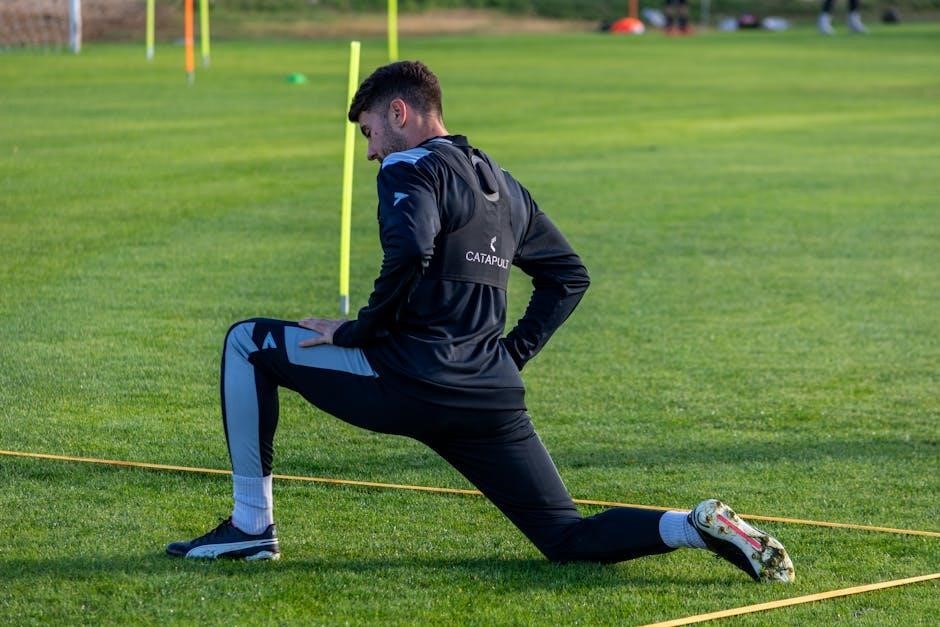
90 day fitness plan pdf
A 90-day fitness plan offers a structured approach to building strength, improving posture, and enhancing cardiovascular health through a combination of exercises and nutrition guidance․
Why a 90-Day Fitness Plan?
A 90-day fitness plan is ideal for achieving significant results due to its balanced duration, allowing enough time to build foundational strength and improve posture while maintaining motivation․ This period enables gradual progression, combining strength training, cardio, and HIIT workouts to maximize muscle development and fat loss․ The structured approach ensures consistency, with each phase building on the previous one, making it easier to track progress and stay accountable․ Additionally, the plan incorporates nutrition and recovery strategies, ensuring a holistic approach to fitness․ This timeline is long enough to see noticeable changes but short enough to keep the journey engaging and focused, making it a popular choice for those seeking sustainable transformations․
Setting Realistic Goals for 90 Days
Setting realistic goals is crucial for a successful 90-day fitness journey․ Aim to build foundational strength, improve posture, and enhance cardiovascular health through consistent exercise and proper nutrition․ Goals should be specific, measurable, and achievable, such as increasing lean muscle mass or improving endurance․ Tracking progress through workout schedules and meal plans helps maintain accountability․ Incorporating strength training, cardio, and recovery routines ensures a balanced approach․ Celebrate small milestones, like completing challenging workouts or noticing physical changes, to stay motivated․ By focusing on gradual progress, you can achieve sustainable results and set a strong foundation for long-term fitness success․ Regular assessments ensure goals remain aligned with your evolving capabilities and aspirations․

Phase 1: Building the Foundation (Days 1-30)
This phase focuses on establishing a consistent routine, introducing basic exercises, and building foundational strength through a mix of strength training and cardio workouts․
Understanding the Importance of Consistency
Consistency is key to achieving fitness goals, as regular workouts and proper nutrition create habits that promote sustainable progress․ Sticking to a structured plan ensures continuous improvement and prevents plateaus․ By committing to daily routines, individuals build discipline and maintain momentum over the 90 days․ Consistency also supports physiological changes, such as increased muscle endurance and cardiovascular health․ Even small, steady efforts contribute to long-term success․ Over time, this dedication fosters a healthier lifestyle, making it easier to stay on track beyond the initial challenge․ Remember, progress is gradual, and consistency is the foundation for lasting results․

Basic Exercises for Beginners
Starting with foundational exercises is essential for building strength and endurance․ Push-ups, squats, and planks are excellent for improving upper body strength and core stability․ Lunges and bodyweight squats target the lower body, enhancing balance and mobility․ Incorporating basic cardio, such as jogging or brisk walking, boosts cardiovascular health․ These exercises are low-cost, requiring minimal equipment, and can be adapted to suit different fitness levels․ Consistency in performing these routines helps establish a strong base for more advanced workouts later in the plan․ Proper form and gradual progression are key to avoiding injury and ensuring steady improvement over the 90-day period․

Phase 2: Increasing Intensity (Days 31-60)
This phase introduces strength training and advanced cardio, focusing on progressive overload to enhance endurance and muscle development․ HIIT sessions are incorporated for improved fat loss and stamina․

Strength training is a cornerstone of fitness, focusing on building muscle and improving overall power․ It involves using weights, resistance bands, or bodyweight exercises to challenge muscles․ During Days 31-60, the plan introduces compound movements like squats, deadlifts, and bench presses, which target multiple muscle groups․ This phase emphasizes progressive overload, gradually increasing weight or reps to stimulate muscle growth․ Strength training not only enhances physical strength but also boosts metabolism, aiding in fat loss․ By incorporating these exercises, individuals can achieve a balanced physique and improve functional strength for daily activities․ Consistency and proper form are key to maximizing results and preventing injury․
Advanced Cardio and HIIT Workouts
Advanced cardio and HIIT (High-Intensity Interval Training) workouts are introduced in Phase 2 to elevate heart rate and burn fat efficiently․ These sessions involve short bursts of intense exercise followed by brief recovery periods․ Examples include sprint intervals, burpees, jump squats, and mountain climbers․ HIIT not only improves cardiovascular endurance but also enhances metabolic rate, helping the body burn calories post-workout․ Cardio exercises like jogging, cycling, or swimming are incorporated to maintain stamina and endurance․ These workouts are designed to push limits, ensuring rapid progress in fitness levels while keeping sessions engaging and time-efficient․ Consistency in these routines accelerates fat loss and improves overall physical conditioning․

Phase 3: Peak Conditioning (Days 61-90)
Phase 3 focuses on peak conditioning, maximizing muscle development, and final fat loss․ Intense workouts refine strength, endurance, and physique, preparing for long-term fitness success․
Maximizing Muscle Development
Maximizing muscle development in the final phase involves advanced strength training and progressive overload․ Focus on compound exercises like squats, deadlifts, and bench presses to target multiple muscle groups․ Incorporate HIIT workouts to enhance endurance while maintaining muscle mass․ Ensure proper nutrition with a caloric surplus, emphasizing protein-rich foods to support muscle growth․ Adequate rest and recovery are crucial, as muscles grow during rest periods․ Track progress through strength gains and body composition changes․ Stay consistent with the workout routine, and adjust intensity to challenge muscles further․ This phase is about refining and building lean muscle, setting the foundation for long-term fitness success․
Final Push for Fat Loss and Endurance
The final phase intensifies fat loss and endurance with high-intensity interval training (HIIT) and advanced cardio routines․ Incorporate exercises like sprints, burpees, and jump squats to boost metabolism and burn fat․ Strength training remains crucial, focusing on full-body workouts to maintain muscle while shedding fat․ Increase the frequency or duration of cardio sessions, aiming for at least 150 minutes of moderate-intensity exercise weekly․ Combine this with a calorie-controlled diet, emphasizing lean proteins, whole grains, and vegetables․ Monitor progress through body fat percentage and endurance levels․ Stay motivated by celebrating small victories, ensuring consistency to achieve desired results by day 90․
Nutrition and Recovery
A structured meal plan with balanced nutrition is key to fuel workouts and aid recovery․ Focus on lean proteins, whole grains, and vegetables, while staying hydrated daily․
Meal Planning for Optimal Results
Meal planning is crucial for achieving fitness goals․ Focus on balanced nutrition with lean proteins, whole grains, and vegetables to fuel workouts and recovery․ Incorporate healthy fats and stay hydrated daily․ Plan meals weekly, portioning food to meet calorie needs․ Avoid processed foods and opt for nutrient-dense options․ Pair meals with post-workout recovery snacks to replenish energy stores․ Track macronutrient intake to ensure alignment with fitness objectives․ A well-structured meal plan supports muscle growth and fat loss, while maintaining energy levels throughout the day․ Consistency in nutrition is key to maximizing progress over the 90-day period․
The Role of Rest and Recovery
Rest and recovery are essential for muscle growth and overall progress․ Adequate sleep and downtime allow your body to repair and adapt to the demands of training․ Aim for 7-9 hours of quality sleep nightly to support recovery․ Incorporate rest days into your routine to prevent overtraining and injury․ Active recovery, such as light cardio or stretching, can enhance blood flow and reduce muscle soreness․ Proper recovery ensures you maintain energy levels and consistency in your workouts․ Neglecting rest can hinder progress and lead to burnout, making it a critical component of your 90-day fitness plan․

Tracking Progress
Tracking your fitness journey is crucial for motivation and accountability․ Use a workout journal, progress photos, and body measurements to monitor improvements․ Stay consistent and adjust your plan as needed for optimal results․
How to Monitor Your Fitness Journey
Monitoring your fitness journey is essential for tracking progress and staying motivated․ Use tools like a workout journal to log exercises, weights, and reps․ Take progress photos weekly to visualize changes in your physique; Measure body fat percentage and track weight loss or muscle gain․ Incorporate accountability by sharing your journey with a friend or online community․ Adjust your plan based on performance and how your body responds․ Celebrate small milestones to stay motivated and ensure consistency․ Regularly reviewing your progress helps maintain focus and drives you toward achieving your 90-day fitness goals effectively․ Consistency and patience are key to success․
Motivation and Accountability
Motivation is the driving force behind a successful 90-day fitness journey․ Set clear, achievable goals and remind yourself of them daily․ Share your progress with a friend or online community to stay accountable․ Use a fitness journal or app to track workouts, meals, and progress photos․ Celebrate small victories, like completing a challenging workout or noticing physical changes, to stay motivated․ Join fitness challenges or accountability groups for support․ Consistency is key, so create a routine and stick to it․ Tracking your journey visually, through photos and measurements, helps maintain focus․ Stay positive and remind yourself why you started—every step brings you closer to your goals․ Accountability ensures you stay committed and motivated throughout the 90 days․